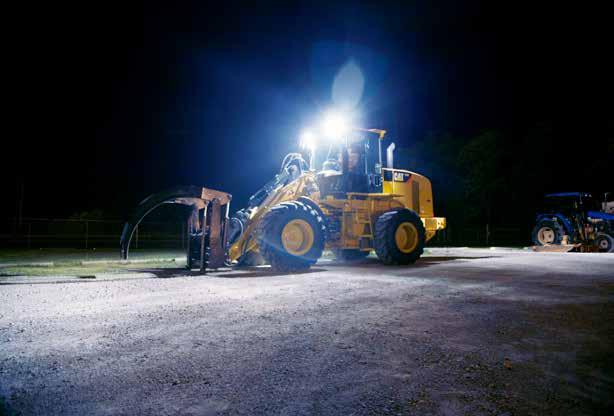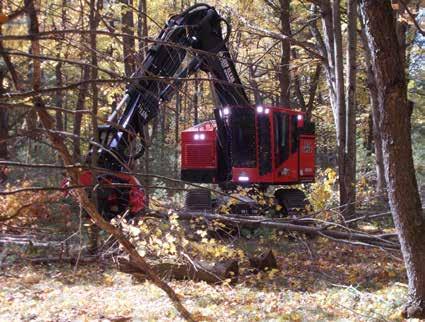
9 minute read
Creating a Safer, More Productive Lit Environment for Construction Workers
Creating a Safer, More Productive Lit Environment for Construction Workers by Del Williams, Grote Industries
Working with an expert can help to optimize lighting for vehicle hazards, grounds, scenes, and surfaces
Advertisement
For fleet managers of construction/ upfit vehicles with staff working in dangerous roadside, off-road, or construction site conditions, using the right quality of lighting can be the difference between life and death.
Roadside crews especially need effective hazard/strobe lights to warn nearby drivers of danger to prevent them from driving into the work zone. But even off-road or building site construction crews need similar protection to keep any traffic or work vehicles away from their workspace.
In these cases, safety is determined not just by using bright lights on the vehicle, but by producing optimal light quality to fully illuminate the environment and attract the attention of those nearby.
Proper lighting is also required to effectively light up the ground and surroundings, so the construction/ upfit vehicle will not be driven or backed into a ditch, off a cliff or into any unsafe condition, in what otherwise can sometimes be complete darkness.
In addition, effective lighting is also needed at the jobsite, so construction workers can safely and efficiently complete any necessary tasks without endangering themselves or others. This includes effectively lighting up the scene and any work surfaces, so tools or equipment can be quickly accessed and safely used.
For versatile construction work trucks, this may require effectively lighting up open cargo areas, material racks, or hauling platforms for large-item storage. For accessing often-used equipment, external compartments, or over-and-under body toolboxes, these areas may also need to be lit up.
When making such lighting choices for upfit vehicles, working with an expert can help to optimize these lighting options for safety and productivity. The end result often reduces worker fatigue, stress, and error, while dramatically reducing maintenance, repair and replacement.
Hazard/Warning Lights With so many distracted drivers today, it is critically important to get the attention of nearby drivers to protect any construction workers that could be in harm’s way.
So, typically, SAE Class 2 warning lights are used for construction vehicles that work along roadsides, while Class 1 warning lights (with four times the intensity of Class 2 lights) are used for emergency vehicles like fire, police, and ambulance. A variety of colors are also used, such as red for emergency vehicles and amber for vehicles that obstruct or impede traffic.
“To alert other drivers, when service vehicles may unexpectedly stop, turn, or move out of regular traffic flow, it is easy to incorporate strobe lights in hideaway areas such as in headlamp, tail, turn, or back up lamps that do not require additional mounting. Beacons or bar strobes can also be added. There are many options,” says Mark Blackbird, Director of National Fleet Sales at Grote Industries, a U.S.-based manufacturer and expert in vehicle lighting and safety systems.
Ground Lighting
When upfitted construction vehicles have to drive or back up over uncertain terrain at night – sometimes in complete blackness – it is crucial to have good ground lighting, so the vehicle can safely navigate obstacles and does not end up in a ditch, hole, or other hazard.
While some manufacturers still use incandescent or halogen lights for ground lighting, these tend to fail prematurely due to short bulb life and high heat, which can put construction workers at risk.
Instead, Blackbird recommends the use of advanced LED lights, which can last up to 10 times longer than
Examples of how lighting can make a job easier - whether night work or cleaning up brush in dense forest.

Just as important, such LEDs can provide significantly better light quality, which equates to better visibility and safety in dark environments, where there may be no other nearby light source
“Unlike traditional bulbs, the best LED lights today also can provide an even, high-quality white light color that is easier on the eyes and provides a contrast similar to natural sunlight for better visibility,” says Blackbird.
All ground lights should also be mounted below the vehicle shining downward, typically at a – 40° inclination, so the actual light source is not visible to the construction vehicle driver or others on the scene. “You don’t want to directly view the light source providing the ground lighting, or it can dilate your pupils, so your eyes are no longer adjusted for nighttime viewing,” explains Blackbird.
Scene Lighting
Scene lighting is used when highpowered, long-range illumination is required from a construction vehicle, and usually takes the form of work lamps. Again, advanced LEDs are used when safety is paramount, and night must essentially be turned into day. This can help to eliminate stumbles, trips, falls, and work-related errors due to poor visibility.
However, there are different types of construction scene lighting, some of which are better suited for specific tasks.
“When construction work area lights are used on the rear of the vehicle, flood or wide flood LED lights cover the broadest area,” says Blackbird. “To light up an area at a distance, we recommend trapezoid or combination light patterns. For the longest distance viewing, a spot light or pencil beam type pattern is usually the best choice.”
In terms of light quality, LEDs are far superior to halogens. Because the color of LEDs is closer to that of daylight than the yellowish hue of halogens, it appears brighter and can illuminate details of objects in the distance better.
LEDs also help construction workers see more at the edge of the scene, where traditional lamps tend to fade out. This improves safety and reduces eye strain since it helps the worker more quickly and easily spot potential dangers and other important details. For the same reason, it also can increase worker productivity, particularly when the task lasts for many hours.
Surface Lighting
Typically, surface lighting is called for when safe footing up steps or quick access to construction tools, equipment, and materials in compartments, truck beds and cargo areas is required.
While this can be accomplished by mounting LED lamps on the side of steps, or at the ends of compartments, an increasingly popular alternative is to install LED light strips wherever needed. Advances in thin-film LED technology not only produce brighter illumination, but do so using paperthin, ultra-light strips that can be easily installed into the existing lighting power system.
The most rugged are resistant to damage from impacts, waterproof, able to withstand pressure washing with hot water, and resistant to the most common chemicals associated with vehicles in the event of exposure or spills, including motor oil, diesel fuel, battery acid, gasoline, and brake fluid. Installation usually involves just peeling off double-sided tape and pressing the LED strips into place.
The bottom line is that any construction fleet manager of upfitted vehicles can create a significantly safer, more productive lit environment for their staff working in the field.
Those who consult with a lighting specialist can not only optimize such choices, but also save dramatically on maintenance, repair and replacement over the service life of the vehicle fleet.
The Future of Lighting
The future of LED lighting looks bright. In the next decade, the lighting experts expect for the LED category to expand as more companies in the construction industry recognize the true value.
Another expansion will be that of smart lighting options that can be controlled remotely with a mobile app.
Since 1901, innovation has been the hallmark of Grote Industries. From durable, easy to see stop lights to the latest in LED lighting technology, Grote has been leading the way in advanced vehicle system solutions from early in the last century right up to today. With these innovations, Grote has helped millions of people throughout North America and the world benefit from the innovation and design excellence of Grote products. For more information, contact Grote at 2600 Lanier Drive, Madison, Indiana 47250; phone: +1 (800) 628-0809; e-mail: info@grote.com; or online at www.grote.com












What Contractors and Subcontractors Need to Know About Integrated Project Delivery Tuesday, April 14, 2020 12 p.m. to 1:00 p.m. Eastern / 9 a.m. Pacific
Presenter: Kevin G. Amadio, Esquire
IPD, in which Owner/Developers, Design Professionals, Contractors and Subcontractors agree in advance to work collaboratively in the design and construction process is becoming more commonplace in the Philadelphia construction marketplace. Kevin Amadio, a Kaplin Stewart partner, will discuss many of the practical and legal changes that come with the IPD process, and his experience using IPD. Join the webinar and learn about how IPD affects your role and responsibilities on a construction project. Click here to register.
TH E
Practical Subcontractor Solutions to Common Legal Disputes in Construction Tuesday, May 12 12 p.m. to 1:00 p.m. Eastern / 9 a.m. Pacific
Presenter: Jason Ebe, Snell & WIlmer
Jason Ebe will review and provide practical advice for subcontractors facing legal disputes common to construction projects, including recommendations on what to do when:
• Actual site or work conditions don’t match the representations in the plans and specifications
• The owner or GC orders changes in the work or the schedule without written acknowledgment
• The subcontractor’s performance is hindered or disrupted by the owner, contractor or other subcontractors
• Plus other issues
Jason Ebe serves as co-chair of Snell & Wilmer’s nationally ranked construction industry practice. Jason frequently represents subcontractors in all aspects of construction transactions and disputes. He is a frequent counselor, negotiator, litigator, author and speaker on a wide range of construction issues and topics, is active in the ASA and has served as past chair of the ASA National Attorneys Council. •
Coming Up in the March 2020 Issue of ASA’s
Theme:
Thinking About Taxes
• Tax Considerations Going Forward Turning the Corner on Auto Claims Hiring for Culture Fit vs Experience Human Reclamation Through Bricklaying
Look for your issue in March.
To access past issues of The Contractor’s Compass, please click here.
For questions about subscribing, please contact: communications@asa-hq.com
TM
AMERICAN ASSOCIATION SUBCONTRACTORS
ASAdvantage 2019-2020 Program
AMERICANS SUBCONTRACTORS ASSOCIATION, INC.
AN AFFINIT Y PROGRAM OF SIGNIFICANT SAVINGS & BENEFITS FOR ASA MEMBERS
WWW.ASAONLINE.COM

ASADVANTAGE PARTICIPATING PROVIDERS




















